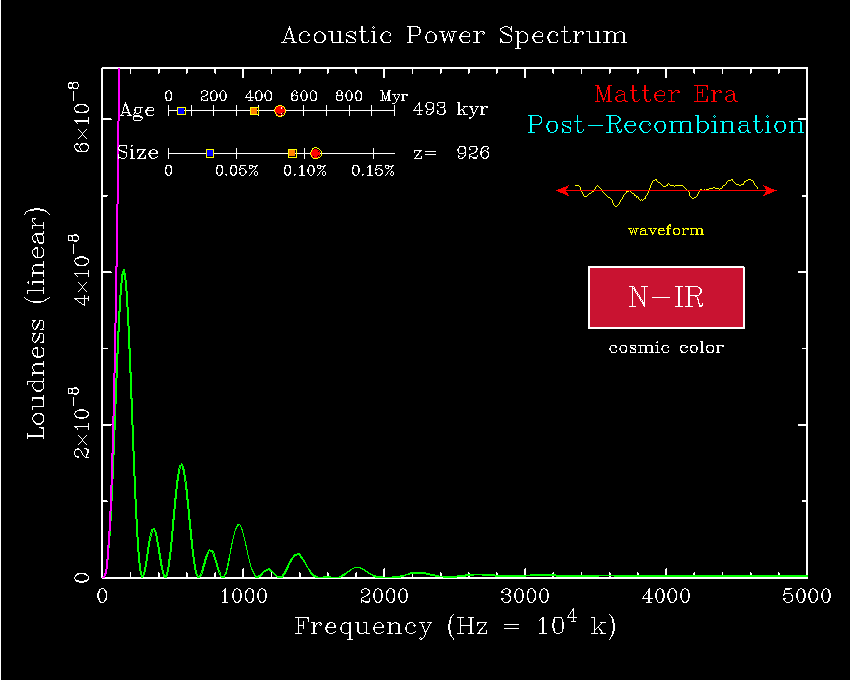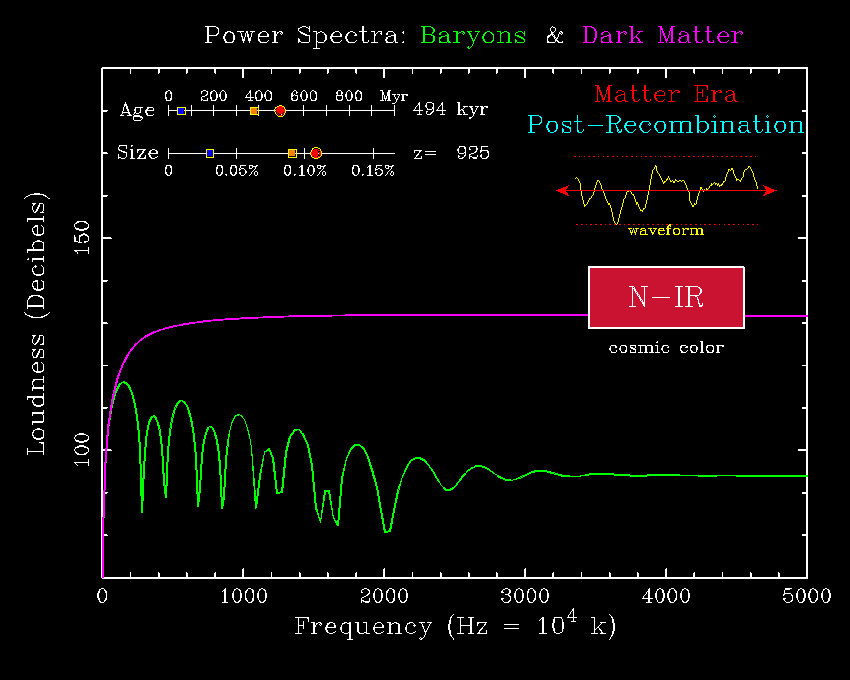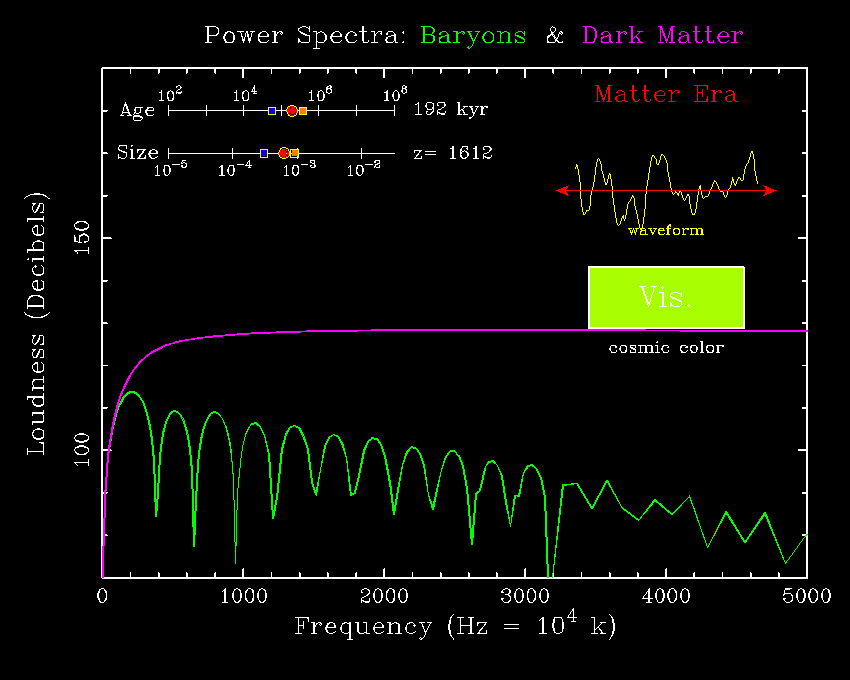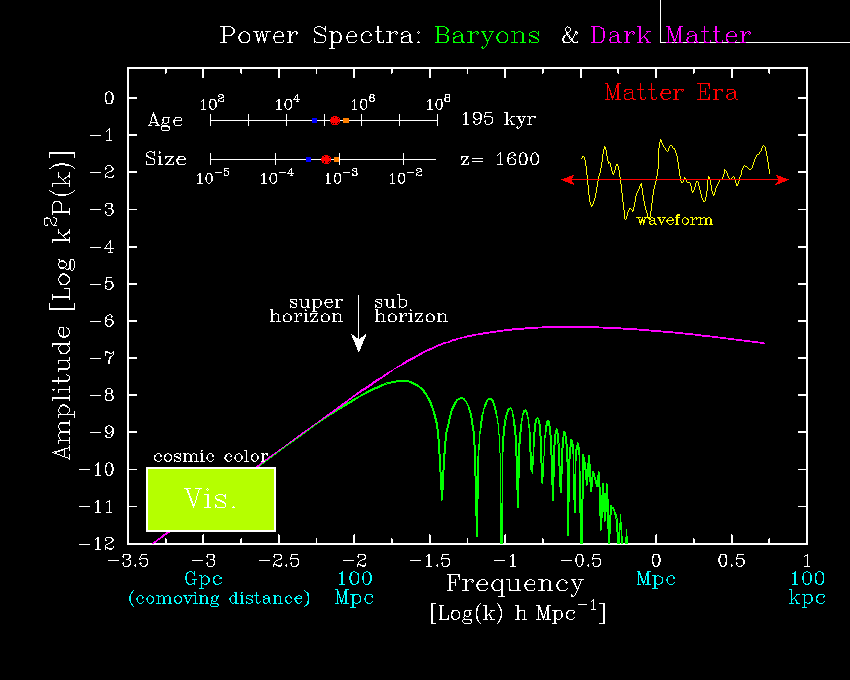Axes: Frequency & Loudness both Linear.

Run movie (1.4 Mb)
Sound only
Varying volume (authentic)
We are ready to roll the movies, and follow the first 1 Myr in detail, followed by the first 100 Myr.
After following the story so far, with its different characters and twisting plot, you could be forgiven for feeling you're in a bit of a fog yourself. We've tracked quite a range of topics, all building to a whole. Our main plot line tells how the CMB is used to measure sound waves in the early Universe, which then guides our use of computer models to follow their development across the first 100 million years. Sub-plots have explored the nature of sound and sound spectra; how cosmic sound is generated and how it acquires its fundamental and harmonics; how distortions arise and are removed; how we can extract music embedded in the sounds; and how dark matter helps transform sound into stars and galaxies.
Let's now step back and take stock of the full sound sequence, noting at least some of these sub-plots en route. Because there are such large changes in the sounds, we're going to break the evolution into a few stages so we can follow clearly the various transitions. The next two figures focus on the first one million years, while the two following track the first hundred million years, using a exponential time progression, which gives all stages similar prominence.
The next slides show two movies of the evolving sound spectra: green for atomic gas, and purple for dark matter. The movies are identical except for the y-axis scales: The first is linear in loudness; the second is in decibels (log loudness). Time flows normally but quicker than reality: 10 seconds spans a million years, so that's 100,000 years per second! In the first movie the volume level is is allowed to increase properly over time (the actual volume depends, of course, on the speakers & amplifier you are using — to be accurate, you need about 110 decibels at 400,000 yrs; but this would bust your speakers and deafen you by 1 Myr). In the second movie, the volume is held constant. The movies also show the changing sound waveform and sky color, as well as the passage of time and growth of cosmic size (compared to today's size).
| First Million Years. Axes: Frequency & Loudness both Linear.  |
Run movie (1.4 Mb) Sound only Varying volume (authentic) |
Notice the entire era unfolds when the Universe is less than 0.1% of its current size! Watch how the fundamental and harmonics move to lower frequencies as the pitch drops, and listen for the rapid growth in volume and hiss after 400,000 years when the fog clears. At this time the gas begins to inherit the structure of the dark matter and high frequencies are reintroduced. Notice also how the even (rarefaction) harmonics quickly vanish near the time of fog clearing, while the odd harmonics continue to grow. Notice also the link between sky color and sound — the Universe is still blue-hot while the pitch is dropping, but is orange/crimson at fog clearing.
| First Million Years. Axes: Frequency Linear; Loudness Exponential (Decibel).  |
Run movie (1.4 Mb) Sound only Constant volume |
Below are two movie versions of the first 100 million years. Note that in both these movies time advances exponentially so that we can follow evenly the rapid initial changes and the final slow ones (2 seconds spans an increase in time by a factor of 10). Although this isn't natural for human perception of time, in some ways it matches more closely how cosmologists view the passage of cosmic time. To avoid either initial silence or final cacophony, one must modify the growth in volume: The first movie fakes the increase, while in the second it is held constant. Both loudness (y-) axes are in exponential (decibel) form, which gives the harmonics their inverted 'U' shape. Finally, the frequency (x-) axes are different: linear in the first movie, and exponential in the second.
| First 100 Million Years. Axes: Frequency Linear; Loudness Exponential.  |
Run movie (1.6 Mb) Sound only Varying volume (authentic) |
Notice how the exponential time flow lingers on the opening very high pitched beginning of the descending scream; while the transition across fog clearing is very abrupt; and the long buildup of high frequency hiss passes quite quickly. This time stretch also helps us follow the sky color changes, starting with Extreme-Ultraviolet, through Visual, to Near-Infrared and finally Far-Infrared.
| First 100 Million Years. Axes: Frequency & Loudness both Exponential.  |
Run movie (1.8 Mb) Sound only Constant volume |
This is a scientifically denser diagram, adding a wavelength scale in 'co-moving' (today's) length on the lower axis, and indicating the growing horizon size. Only regions smaller than the horizon can support true sound waves.